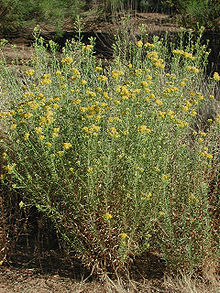Isocoma acradenia
| Isocoma acradenia | |
|---|---|

| |
| Scientific classification | |
| Kingdom: | |
| (unranked): | |
| (unranked): | |
| (unranked): | |
| Order: | |
| Family: | |
| Tribe: | |
| Genus: | |
| Species: | I. acradenia
|
| Binomial name | |
| Isocoma acradenia (Greene) Greene 1894
| |
| Synonyms[1] | |
|
Synonymy
| |
Isocoma acradenia is a North American species of flowering plant in the daisy family known by the common name alkali goldenbush.
It is native to the Southwestern United States (California, Nevada, Utah, Arizona) and northwestern Mexico (Sonora, Baja California). It grows in arid, sandy areas, particularly mineral-rich areas such as alkali flats and gypsum soils.[2][3][4][5][6]
Description
Isocoma acradenia is a bushy subshrub reaching maximum heights of slightly over a meter (40 inches). It produces erect, branching stems which are a shiny pale yellowish white, aging to a yellow-gray.[7]
Along the tough, hard-surfaced stems are linear or oval-shaped glandular leaves 1–6 centimetres (0.39–2.36 in) long, sometimes with stumpy teeth along the edges. They are gray-green and age to pale gray or tan. [7]
The inflorescences along the top parts of the stem branches are clusters of four or five flower heads.[8] Each head is a capsule encased in bumpy, glandular greenish phyllaries bearing many golden yellow disc florets at its mouth. Each disc floret is somewhat cylindrical and protruding. [7]
The fruit is an achene a few millimeters long, with a yellowish pappus adding another few millimeters.[7]
- Isocoma acradenia var. acradenia - Salt scrub, often with creosote - Arizona, California, Nevada, Sonora
- Isocoma acradenia var. bracteosa (Greene) G. L. Nesom - salt flats - southern Central Valley in California
- Isocoma acradenia var. eremophila (Greene) G. L. Nesom - sandy soils, dunes, etc. - Arizona, California, Nevada, Utah, Baja California, Sonora).
References
- ^ a b The Plant List, Isocoma acradenia (Greene) Greene
- ^ C.Michael Hogan, ed. 2010. Isocoma acradenia. Encyclopedia of Life
- ^ Biota of North America Program 2014 county distribution map
- ^ a b Calflora taxon report, University of California, Isocoma acradenia (E. Greene) E. Greene, Desert isocoma, alkali goldenbush
- ^ a b SEINet, Southwestern Biodiversity, Arizona chapter
- ^ Nesom, G.L. 1991. Taxonomy of Isocoma (Compositae: Astereae). Phytologia 70(2): 69–114 includes distribution map on page 72
- ^ a b c d e Flora of North America, Isocoma acradenia (Greene) Greene, Erythea. 2: 111. 1894. Alkali jimmyweed
- ^ Jepson Manual Treatment, University of California, (TJM93) of Isocoma acradenia
External links
- Calflora Database: Isocoma acradenia (Alkali goldenbush, Desert isocoma)
- USDA Plants Profile for Isocoma acradenia (alkali goldenbush)
- Jepson Manual eFlora (TJM2) treatment of Isocoma acradenia
- UC CalPhotos gallery − Isocoma acradenia
- Isocoma
- Flora of the Southwestern United States
- Flora of Northwestern Mexico
- Flora of California
- Flora of the California desert regions
- Flora of the Sonoran Deserts
- Natural history of the California chaparral and woodlands
- Natural history of the Colorado Desert
- Natural history of the Mojave Desert
- Plants described in 1883
- Taxa named by Edward Lee Greene
- Astereae stubs
